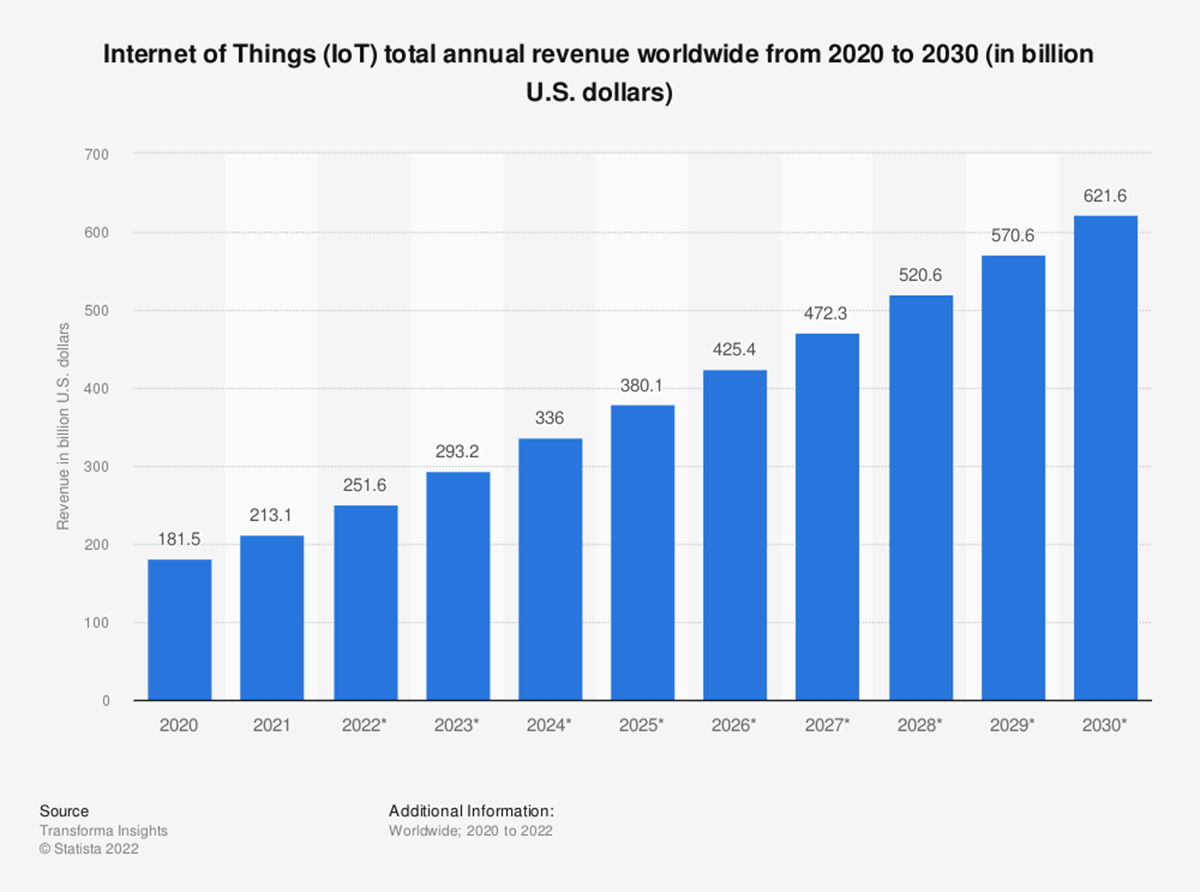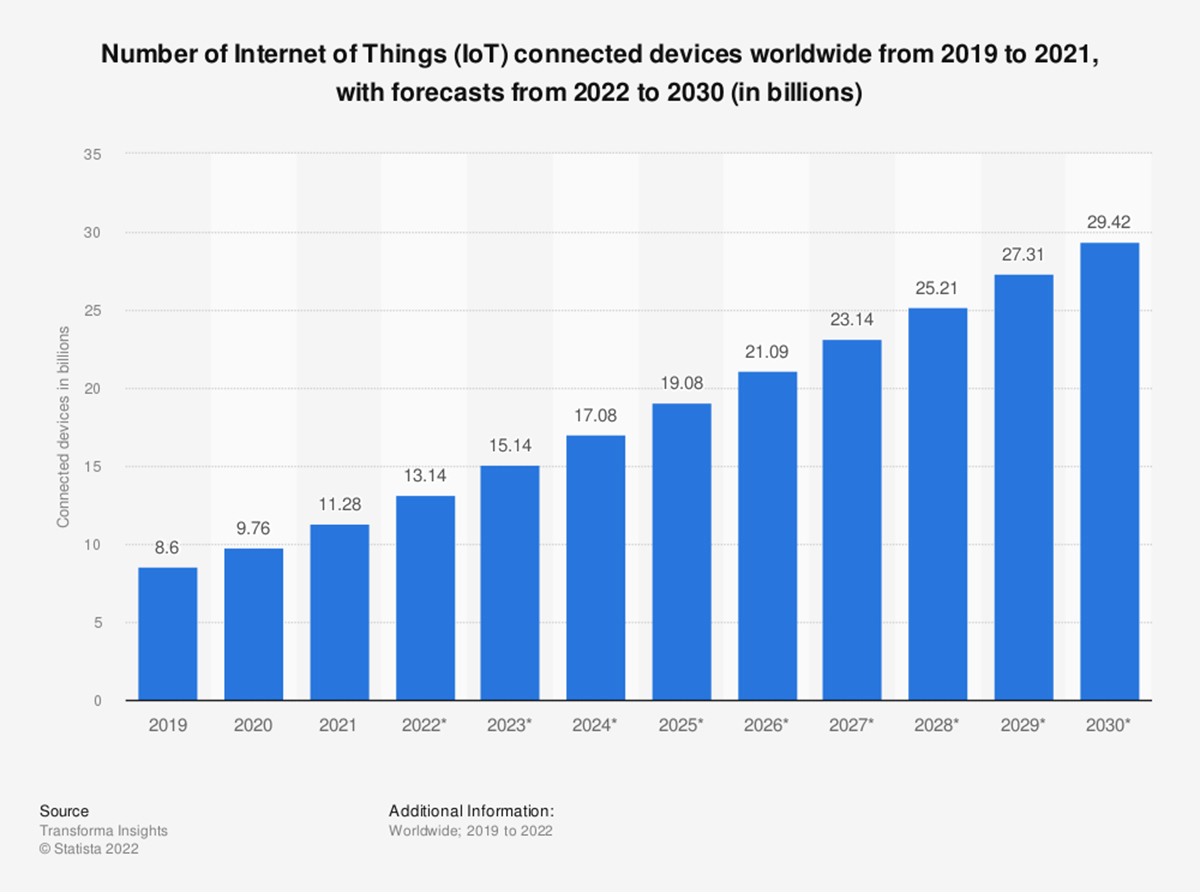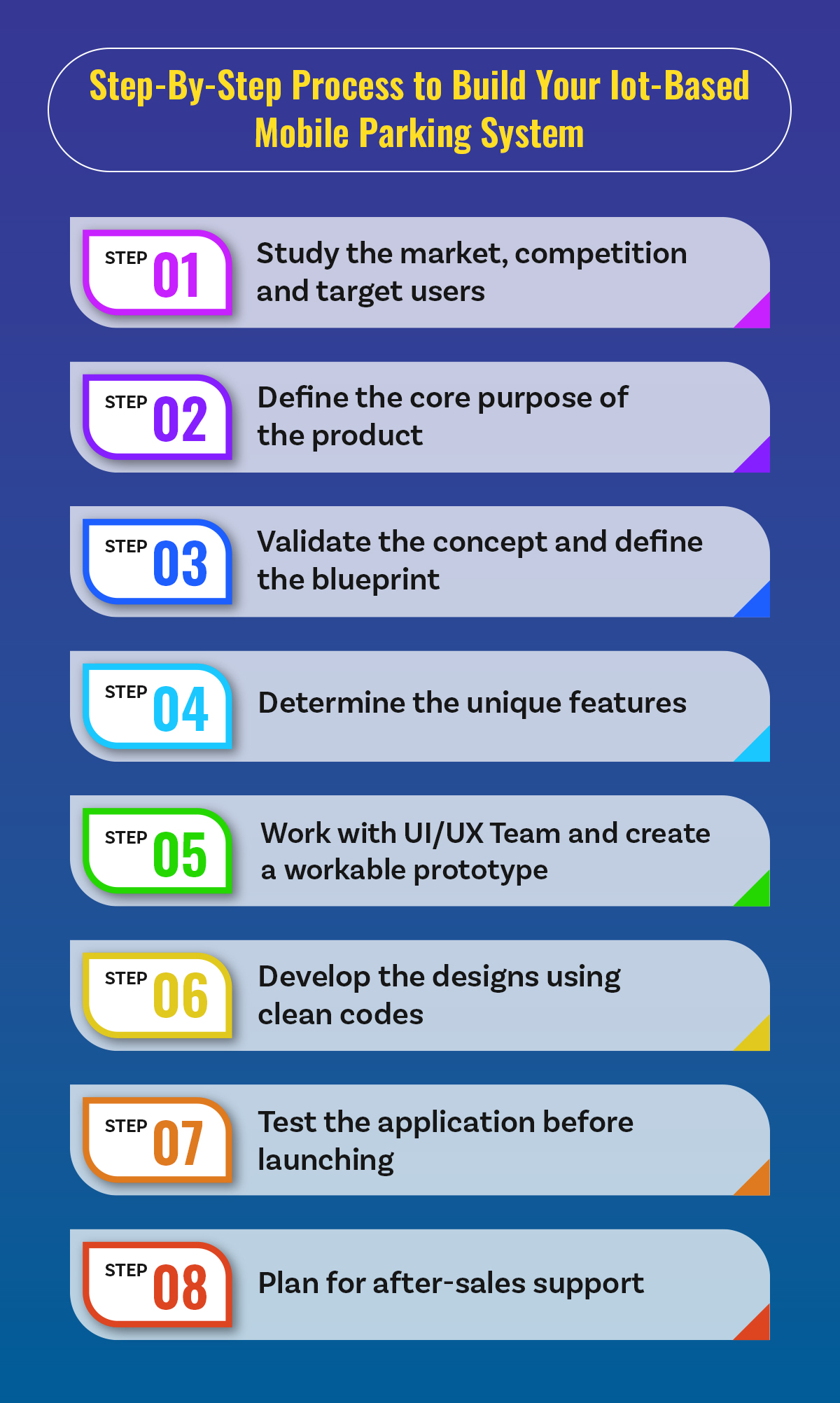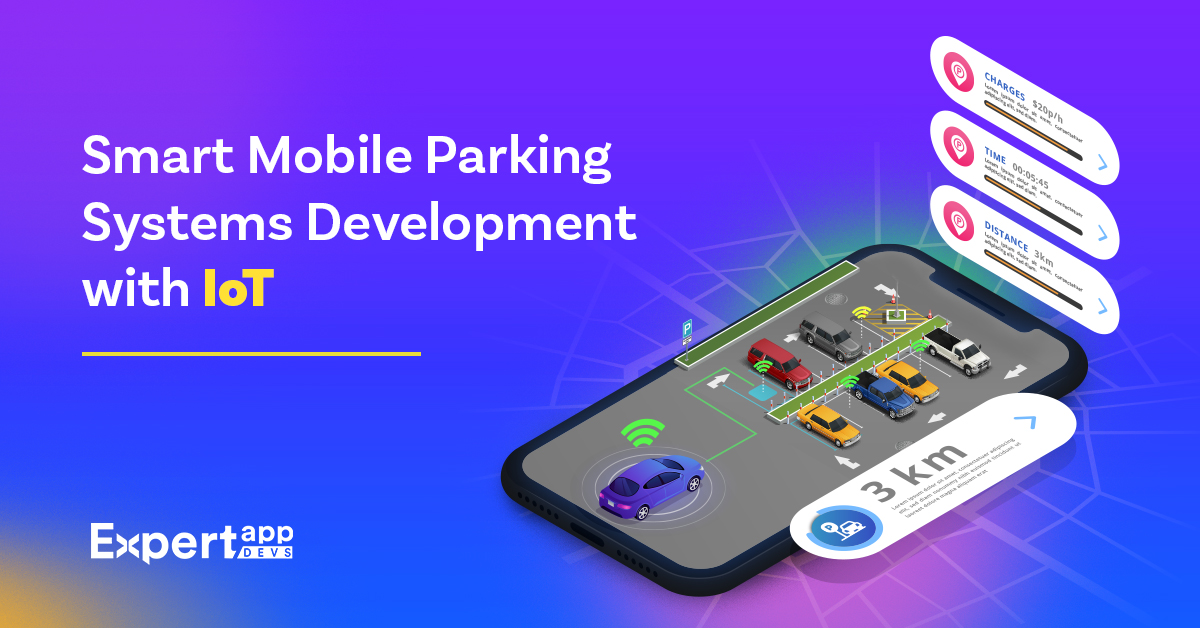How to Build an IoT-Based Smart Mobile Parking System?
Speed and agility are at the core of transforming organizations embracing technology, and pivoting digitally. As a result, there is a growing need for intelligent systems that can automate processes, improve productivity and enhance digital business opportunities.
The amalgamation of physical (hardware components, sensors), software (digital technology), and human, also known as Industry 4.0, is essential for a more interconnected and data-driven world.
The Internet of Things offers a more sustainable and efficient management of Industry 4.0. It helps build an interactive connection between machines and humans through the Internet.
Several businesses and systems are adopting this current technology. The total revenue from IoT devices is expected to reach $621.6 billion by 2030 (Statista).

The parking system is the recent adopter of this current technology. They are also contributing towards this parking system.
The current parking system is inaccurate and inefficient.
- Long lines to finally get a parking spot
- Dependency on security to help find a spot
- The recording is manual and logged using paper systems
- Security is not full-proof
- Visitor parking or other parking facilities are not managed
IoT parking systems at the core can help you resolve the issues that come with manual or non-automated parking systems. It can improve the connectivity between physical systems and software for better insights and decision-making.
This guide will look at the IoT-based smart mobile parking system in detail. We will understand the application's creation process and the must-have features of a popular application.
What is a Smart Parking System?
The smart parking system combines technology and resources to identify parking availability, ticket logs, and other details. It combines hardware, such as cameras and sensors (parking and counting), with software solutions.
The two communicate over the Internet to grab real-time data. The user will know whether a parking spot is available or occupied.
In the case of paid parking facilities, the user would know what the approximate pricing for the spot is. You can also determine how far a parking spot is from where you plan to visit.
You can plan your visit according to the parking facilities. The idea is to make the city smarter and help people overcome parking challenges.
How Does Smart Parking System Work?
A smart parking system derives the data from the sensors and camera and feeds it into the software systems. Embedded systems, intelligent hardware components, and other physical data-collecting machines can help build the data store for the system.
This process includes search-to-pay features.
- You can use the software application to look for parking spaces nearby when you reach your destination.
- Using the GPS and parking sensors, you will know the available versus occupied spaces in the parking lot.
- The physical data from the sensors and cameras are collected and sent over the Internet to the parking application.
- The user can view these spaces. They can also avail the prices for each space in the map view.
- Once they know the parking that works best for them, they can compare the prices and pay by phone.
- The parking spot is booked for their vehicle. The GPS will also help with the directions to their selected parking spot ensuring stress-free parking.
A wireless signal is sent periodically to the cloud using IoT devices or embedded systems. This will help keep the parking app updated with a real-time view of allotted spaces.
Using the parking application, the user can also get an idea of the deals and discounts available for parking. If you plan to use the spot regularly, you might get a monthly discount on your parking fee.
Most parking apps accept online payments. However, some apps have introduced multiple payment formats (credit cards included) for customers for street parking.
The Components of the Smart Parking System
Let’s look at the top components to create the ultimate smart parking system for your requirements.
The sensor is an integral part of the smart parking solution. It can detect the vehicle and let the user know whether the parking space is occupied. There are three types of sensors.
- The ultrasonic sensor uses ultrasound to measure the data.
- The electromagnetic sensor uses a magnetic field. This means it sends relevant data when the metal objects are closer to the sensor.
- Infrared sensors can use temperature to determine whether the space is occupied. It will use temperature units to detect the motion of the vehicle.
- The sensors and microcontrollers inside the system help with data processing, which is important for real-time data cleaning and management.
- The cloud platform helps in storing and processing data.
- The mobile application is the software part of the parking system. It will help with client-side communication.
While you are on the topic of sensors, it is equally important to know how these sensors function to get accurate results on car parks.
The devices in the IoT parking systems should recognize if a spot is empty or occupied. This is possible when it can detect the presence of a vehicle. The sensors can also send out details on actual parking sessions.
You can use the technologies such as computer vision, proximity detection, and distance detection to calculate the data. The sensors can also help detect the parking slot where multiple vehicles can stay simultaneously.
You must find a sensor for each function to derive the exact data. You might want to use LoRa (Long Range) sensors for this functionality. They are simple long-range sensors requiring a long battery life to prosper.
- The parking spaces come with a battery-powered sensor (LoRa sensors), which can measure the arrival or departure of the vehicles. Each unit in these sensors comes with a unique MAC address along with a serial number and barcode.
- When the sensor detects any activity, it will send the message to the receiver using a wireless network gateway.
- The gateway, in this case, would be a part of the LoRa network defined by the service provider. The sensor would send the packets to the PIN cloud application.
- The sensor data is used to track the details of the parking lot. You can then convert this data through the storage service to a mobile or web application, depending on where your users are present.
- The LoRa sensors offer two-way communication, which enables fast-tracking of queries.
Now that we have understood a bit about smart parking systems and how the sensors function, let’s talk about how it is different from traditional parking systems.
Traditional vs Smart Parking Systems: A Quick Comparison
The traditional parking systems have been well-identified within the circle. A lot of people depend on these systems to find their space. However, the unconventional method of the mobile app is taking over.
- When you are working with traditional parking systems, they aren’t dependent on a power supply. The IoT-based smart systems run using power and cannot survive without the sensors. These sensors can transmit only when the mains are on.
- You need more resources, space management, logging materials, and more to manage the traditional systems. With fewer resources and greater agility, you can manage mobile applications.
- With traditional systems, you may not get the security you desire. In most cases, if no one is standing at the entrance, your vehicle details are not logged.
However, that is not the case with smart parking systems. Every vehicle captured by the sensor systems is logged into the mobile application.
- If you abide by the traditional parking systems, you will encounter delays through a long waiting line. However, with smart systems, you can reduce time wastage and increase parking efficiency.
- Visitor parking in the traditional systems is manually done. You can miss out on some of the visitors. As it is automatically logged, you are sure to find proper spaces for the visitors in your parking.
Let’s look at all the steps in building the IoT-based mobile parking system.
Step-By-Step Guide to Develop Iot Based Mobile Parking System
It takes a while to get an IoT-based mobile parking system ready for your requirements. The number of connected devices will reach 29.4 billion by 2030 (Statista).

Designing a high-performing and efficient system will be difficult if you don't follow a process.
We have created a step-by-step process to create your IoT-based mobile parking system. This will include the design creation and feature selection too.

1. Study the market, competition and target users
When you are studying the parking system market, it is very niche. There are vehicle users. You can further niche based on corporate, leisure, and commercial vehicle parking.
Once you know your idea's aims, you must study the target users. What type of communication systems they are using?
Identify the parking issues they are currently facing. Know who your direct competition is for this segment. You will find that this information can help you enhance your idea and create the perfect solution.
2. Define the core purpose of the product
The core will help you define the vision, plan your goals and outline your app idea. it is the core purpose of the application that will help you reinvent the solution.
Start by knowing why you are creating the application. Determine the existing systems, the issues the users face, and how your idea can help overcome them.
This will help improve the vision for the application and further down the objectives or goals.
3. Validate the concept and define the blueprint
Once your idea for the mobile parking system is clear and on paper, it becomes easier to validate with the audience. Know whether your people would be ready to use your planned application.
Validation is key to knowing the conversion rate and downloads for the application. Once validated, determine the plan for creating the application.
Your blueprint should include details from the app concept to design preparation. You might want to define the tech stack, development methodology, and approach.
4. Determine the unique features
This is an important part of your application development. You should define the phase-wise features. For example, some features are important for prototype development. Your advanced app would be in the last phase, so keep all the complex features for that phase.
5. Work with UI/UX Team and create a workable prototype
Once you have the plan and features ready, collaborate with the UI/UX team. Your design should be in sync with your end users. Know what they need, how they use an app, and how they would behave with your application.
The UX strategy is key to gaining engagement and preparing an experiential application. You should plan for one-hand holding, landscape screens, and other behavior exhibited by your users.
6. Develop the designs using clean codes
Once your designs are ready based on the UI and UX strategy, it is time to convert them into a functional solution. The backend team should ensure smooth communication between the client and server ends.
Your codes should be clean and documented. This can help during the testing and maintenance phases as well. even when you are planning an upgrade, clean codes can help the developer.
7. Test the application before launching
A test-driven approach can help you manage the application launch on time. you might want to check the app for coding issues, bugs that arise from codes, and reusability.
You might also want to test the unit and functions to check if they work properly. Identify all the tests that you need to get done before releasing the application.
Plan for each test and write the test cases. Ensure you test the units or functions until they work as they should.
8. Plan for after-sales support
Customer feedback can help you optimize your application. You should have an optimization, feedback-based upgrade, and support plan for the mobile application.
Make sure to include periodic maintenance of the sensors and the application to your duty chart.
How Much Does it Cost to Develop an IoT Parking System
If you plan a smart parking system for your idea, you should also know how much to budget.
The average cost of building the mobile-based parking system would be approximately $40k.
Let’s look at the breakdown of the expenses of building the parking app system.
| Expense Type | The Cost |
| Hardware Expenses: this would include the cost of having a sensor, display panels, and gateways that can transmit the data. |
$6500 (for ten sensors), $1500, and $8500 for the gateways. The total cost would be $16500 |
| Software Development (Basic application) | $10k |
| Recurring Operational Expenses | $12k |
| Equipment Costs | $1500 |
Note: This is an approximate cost. We must consider all these aspects when building a smart parking system for your needs.
Conclusion
Planning an IoT based smart parking system can be quite a tedious affair. You need to plan for the features, validate the idea, and niche down to meet the target audience’s requirements. Planning every aspect of the mobile application is important if you want to gain more downloads and increase parking efficiency.
Partnering with an equally smart technology service provider can help accelerate the development and improve the quality of the solution. Expert App Devs is a leading IoT app development company. We have experience delivering smart parking systems for our top clientele. If you have a similar idea or require any IoT solution, you can connect with our team.
Read More:
Top 8 Reasons Why Developers Use Flutter for IoT Apps
 Jignen Pandya
Jignen Pandya




